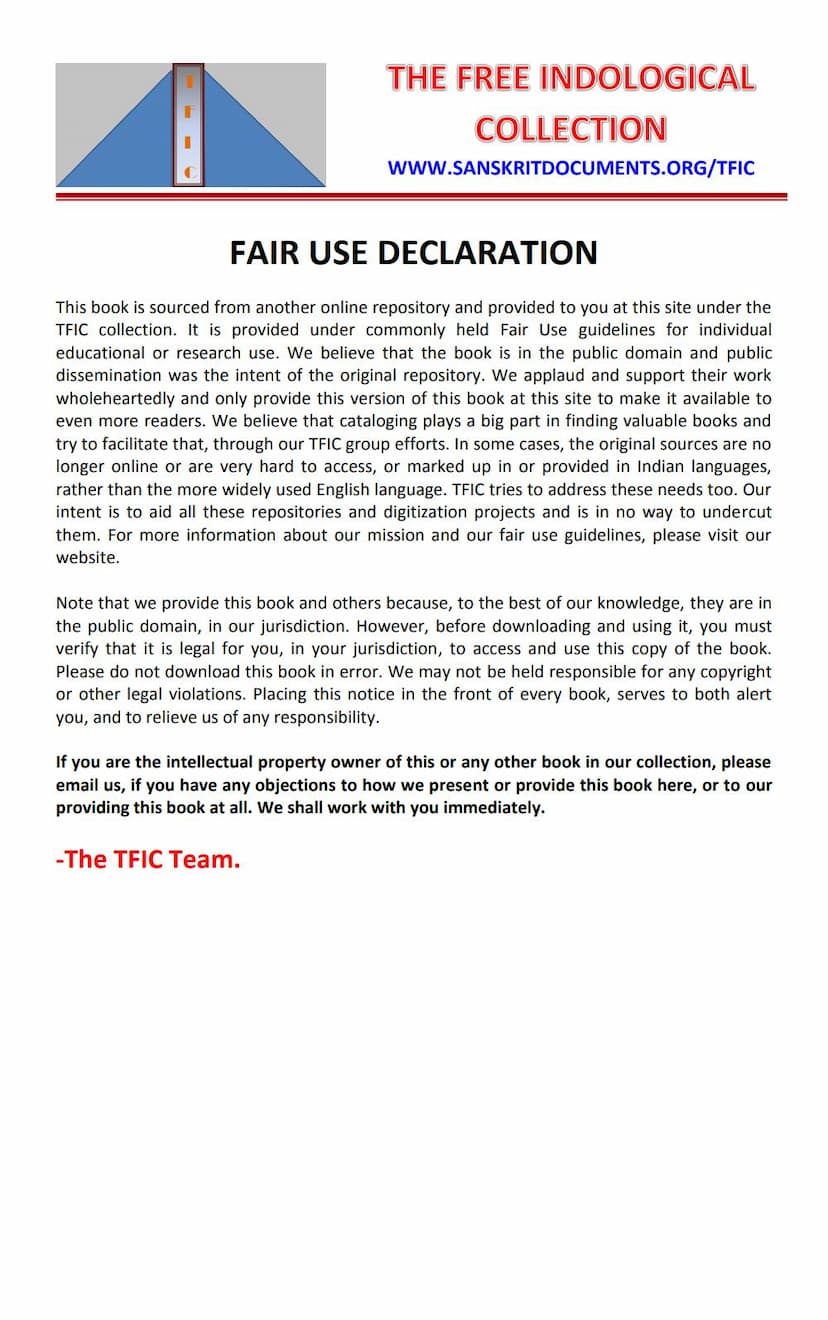Jain Tark Shastra Me Anuman Vichar Aetihasik Adhyayan
Added to library: September 2, 2025

Summary
This book, "Jain Tark Shastra mein Anuman Vichar: Aitihasik evam Sameekshatmak Adhyayan" (Treatment of Inference in Jaina Logic: A Historical and Critical Study) by Dr. Darbarilal Kothiya, published by Veer Seva Mandir Trust, is a comprehensive academic work delving into the concept of inference (anumana) within the framework of Jaina logic.
Here's a breakdown of its key aspects based on the provided text:
1. Subject Matter: The book focuses on the philosophical and logical concept of anumana (inference) as it is understood and developed within the Jain philosophical tradition. It aims to provide a historical and critical analysis of this crucial element of Jaina epistemology.
2. Author and Publisher:
- Author: Dr. Darbari Lal Jain Kothiya, a distinguished scholar with expertise in Jaina philosophy, logic, and Sanskrit literature. His academic credentials and extensive list of published works (editing and translating several Jaina texts) highlight his suitability for this topic.
- Publisher: Veer Seva Mandir Trust, an organization dedicated to promoting Jaina studies and literature. The book is presented as part of the "Yugvir-Samantabhadra-Granthamala: 1," suggesting a series focused on prominent Jaina logicians and thinkers.
3. Historical and Critical Approach: The book is not merely descriptive but also analytical and comparative. It traces the historical development of the concept of inference in Jaina thought, while also critically evaluating different viewpoints. It aims to situate Jaina anumana within the broader context of Indian logic by comparing it with the theories of other Indian philosophical schools (like Nyaya, Vaisheshika, Buddhism, Mimamsa, Vedanta, and Sankhya) and even Western logic (Aristotelian syllogism and Mill's methods).
4. Key Themes and Structure (as outlined in the Table of Contents): The book is structured into five chapters, further divided into twelve sections, covering a wide range of topics related to anumana:
-
Chapter 1: Introduction:
- Discusses the historical development of inference across various Indian philosophical traditions (Nyaya, Vaisheshika, Buddhism, Mimamsa, Vedanta, Sankhya).
- Traces the evolution of inference within the Jaina tradition itself, citing early mentions in Jain scriptures like Shatkhandagama, Sthanangasutra, Bhagavati Sutra, and Anuyogasutra.
- Provides a brief overview of the concept of inference, its constituent parts (like pakshadharmata and vyapti), its types, the process of syllogism, and fallacies of inference.
- Offers a preliminary comparative study of Indian and Western logic.
-
Chapter 2: Jaina Epistemology and the Place of Inference:
- Analyzes Jaina epistemology (pramanavada) and the position of anumana within it.
- Defines the concept of pramana (means of valid knowledge) and its relation to anumana.
- Critically examines the concept of inference in Jaina Agamas and its significance.
-
Chapter 3: Types of Inference and the Concept of Vyapti:
- Explores the various classifications of inference discussed in different Indian philosophical schools and their critique by Jain logicians like Akalanka, Vidyananda, Vadivaraja, and Prabhachandra.
- Delves into the crucial concept of vyapti (invariable concomitance), its nature, the role of upadhi (spurious middle term), and the Jaina approach to establishing vyapti through tarka (reasoning).
-
Chapter 4: Analysis of Syllogistic Components and Reasons:
- Examines the components of syllogism (avayava) based on different classifications and their historical development, including the debated concept of Pancha Shuddhi (five purifications) as proposed by Bhadrabahu.
- Critically analyzes various definitions of hetu (reason or middle term) from different schools and the Jain preference for the ekalaksana (single characteristic) of anyathanupapannatva (non-otherwise-possibility or indispensability).
- Details the extensive classification of hetu found in Jain texts, particularly from Akalanka and Vidyananda.
-
Chapter 5: Fallacies of Inference (Anumana-abhas):
- Discusses the fallacies of inference (anumana-abhas) as presented by Jain scholars like Samantabhadra, Siddhasena, Akalanka, Manikyanandi, Devsuria, and Hemachandra.
- Also reviews fallacies discussed in other Indian traditions (Vaishēṣika, Nyaya, Buddhism) for comparative analysis.
5. Key Contributions of Jaina Logic highlighted in the book: The book emphasizes several unique contributions of Jain logic to the understanding of inference:
- Primacy of Vyapti: Jain logicians, particularly Akalanka, strongly emphasized vyapti (invariable concomitance) as the sole essential criterion for a valid inference, questioning the necessity of other elements like pakshadharmata (property of the minor term).
- Role of Tarka in Establishing Vyapti: The Jain tradition uniquely highlights the role of tarka (hypothetical reasoning or logical analysis) in establishing and confirming vyapti, seeing it as a distinct means of knowledge (pramana) crucial for valid inference.
- Alternative Classification of Hetu: While other schools focused on trirupa (three characteristics) or pancharupa (five characteristics) of a valid reason, Jain logicians like Akalanka and Vidyananda prioritized anyathanupapannatva (non-otherwise-possibility) as the sole essential characteristic, classifying the hetu based on the nature of this concomitance (e.g., tathopapatti and anyathanupapatti).
- Focus on Anumana-abhas: The book meticulously details the classification of fallacies of inference (anumana-abhas) within the Jain tradition, highlighting the meticulous analysis of pakshabhas, hetvabhas, and drstantabhas, and introducing unique categories like balaprayogabhasa (fallacies of improper application).
- Refined Definitions: Jain scholars provided precise definitions of terms like anumana, hetu, and vyapti, contributing to a deeper understanding of logical reasoning.
- Comparative Perspective: The work's strength lies in its comparative analysis, situating Jaina anumana within the broader landscape of Indian philosophical thought and even touching upon Western logic.
6. Academic Significance: The Foreword and Preface (by Prof. Devendra and Dr. Darbari Lal Kothiya respectively) praise the book as a foundational and original work in Hindi on the subject. It's described as a result of extensive research, meticulous analysis, and a balanced presentation of views from various Indian philosophical schools. The book is considered essential for students and researchers in Indian logic and philosophy.
In essence, "Jain Tark Shastra mein Anuman Vichar" is a scholarly endeavor to illuminate the intricate and sophisticated theory of inference within Jainism, presenting its historical trajectory, philosophical underpinnings, and its unique contributions to the field of Indian logic.